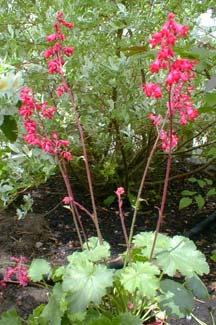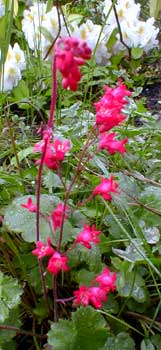
'Firefly' Coral Bells;
aka, Scarlet Alumroot
"Firefly's my name. I am evanescent.
Firefly's your name. You are evanescent."
-Conrad Aiken
(1889-1973)
(1889-1973)
In medieval Catholic folk belief, bells the color of coral protected a household from evil spirts, apparently adapted from an old Roman belief noted by Paracelsus, that beads of coral hung about the necks of infants protected children from illness. Coral beads were thought to be the petrified menses of Aphrodite as Sea-goddess, & were used as charms to protect against shipwreck, fire, & ill weather. The coral beads became coral bells among Christians who additionally believed the sound of bells had power to repel dark spirits.
The red-flowering heucheras obtained the name Coral Bells because they resembled the very bells that protected medieval Catholic households. While the coral-red flowers came to represent Mary, white-flowering heucheras were associated with the purity of Jesus. But the Catholic folkname Our Lady's Bells undoubtedly pre-dates Catholicism, for medieval monastic gardens coopted myths & symbols dating to a time when "Our Lady" addressed the Mother Goddess.
Many of the more ornately leafed varieties of heuchera are derived primarily from HH. micrantha & americana, & can have rather boring flowers of green or white almost too tiny to even count. By contrast the true Coral Bells such as S. sanguinea named for the bright red blossoms lack the extremes of frills & colors of the fancy-leaf varieties.
 'Firefly' (registered in Europe as 'Leuchkafer') is a "brizoides hybrid." All brizoides hybrids having the southwest Rockies' S. sanguinea as the main part of their heritage. It was selectively bred & hybrdized to increase the vermillian intensity of its flowers, the color having a particular appeal to hummingbirds.
'Firefly' (registered in Europe as 'Leuchkafer') is a "brizoides hybrid." All brizoides hybrids having the southwest Rockies' S. sanguinea as the main part of their heritage. It was selectively bred & hybrdized to increase the vermillian intensity of its flowers, the color having a particular appeal to hummingbirds.Though this cultivar lacks unusual leaf coloration, the maply-lobed green basal leaves are neverthelessw extremely pleasant, & strongly evergreen on Puget Sound.
Given that the more intensely leaf-colored varieties can be slow to establish good bushy appearance, are quick to be ruined in winter, then slow to recover in spring, sometimes it is just better to rely on a good basic green leaf such as for 'Firefly,' which can be counted on for a good appearance most of the year.
The basal leaves clump to five or six inches high. Blooms rise one to two feet high, on loose panicles which are particularly flowery May through July. Fewer stems of later flowers can be relied upon, especially with deadheading.
It prefers consistantly moist well draining humousy soil in considerable sun, but will also thrive in partial shade & poorer soil with some bloom loss. It may demand more shade when grown further south, or require a lot more water if in hot sun.
Ours is somewhat shaded by a sweet cherry tree & a thinly branched Rhododendron catawbiense 'Album' beneath which 'Firefly' is nestled (visible in bloom in the second of these May photos). For a similar hybrid, see also H. x brizoides 'Bressingham Pink.'